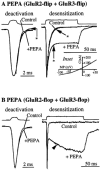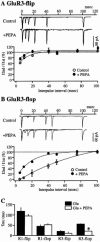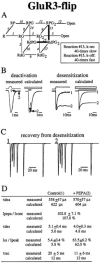A desensitization-selective potentiator of AMPA-type glutamate receptors
- PMID: 12145103
- PMCID: PMC1573432
- DOI: 10.1038/sj.bjp.0704804
A desensitization-selective potentiator of AMPA-type glutamate receptors
Abstract
1: We examined the effects of PEPA, an allosteric potentiator of AMPA receptors, on AMPA receptor kinetics. 2: PEPA did not affect the deactivation of glutamate responses but potently attenuated the extent of receptor desensitization without slowing the onset of desensitization in most of the recombinant AMPA receptors (GluR1-flip, GluR1-flop, GluR3-flip, GluR3-flip+GluR2-flip, and GluR3-flop+GluR2-flop) expressed in Xenopus oocytes. For the GluR3-flop subunit, PEPA attenuated the extent of desensitization and only weakly prolonged deactivation (1.3 fold). 3: PEPA did not significantly affect recovery from desensitization in oocytes expressing GluR3-flip, GluR1-flop, and GluR1-flop, but weakly accelerated (2.6 fold) recovery from desensitization in oocytes expressing GluR3-flop. 4: PEPA's effect on desensitization of GluR3-flop-containing receptors is unique in that onset is very slow. 5: Simulation studies using simplified kinetic models for AMPA receptors are utilized to explore the differential effects of PEPA on GluR3-flip and -flop. It is possible to simulate the action on GluR3-flip by modulating two rate constants in a 12-state kinetic model. For simulation of the action on GluR3-flop, the 12-state kinetic model is not enough, and it is necessary to invoke a 13th state, a PEPA-bound receptor to which glutamate cannot bind. 6: These results suggest that attenuation of extent of desensitization represents the principal mechanism underlying the potentiation of AMPA receptors by PEPA, and that PEPA exhibits different mechanisms with respect to GluR3-flip and GluR3-flop.
Figures






Similar articles
-
Pharmacological detection of AMPA receptor heterogeneity by use of two allosteric potentiators in rat hippocampal cultures.Br J Pharmacol. 1998 Apr;123(7):1294-303. doi: 10.1038/sj.bjp.0701707. Br J Pharmacol. 1998. PMID: 9579722 Free PMC article.
-
A novel allosteric potentiator of AMPA receptors: 4--2-(phenylsulfonylamino)ethylthio--2,6-difluoro-phenoxyaceta mide.J Neurosci. 1997 Aug 1;17(15):5760-71. doi: 10.1523/JNEUROSCI.17-15-05760.1997. J Neurosci. 1997. PMID: 9221774 Free PMC article.
-
Modulation of desensitization at glutamate receptors in isolated crucian carp horizontal cells by concanavalin A, cyclothiazide, aniracetam and PEPA.Neuroscience. 1999 Mar;89(3):979-90. doi: 10.1016/s0306-4522(98)00310-8. Neuroscience. 1999. PMID: 10199629
-
AMPA receptor regulation mechanisms: future target for safer neuroprotective drugs.Int J Neurosci. 2004 Jun;114(6):695-734. doi: 10.1080/00207450490430453. Int J Neurosci. 2004. PMID: 15204061 Review.
-
LY404187: a novel positive allosteric modulator of AMPA receptors.CNS Drug Rev. 2002 Fall;8(3):255-82. doi: 10.1111/j.1527-3458.2002.tb00228.x. CNS Drug Rev. 2002. PMID: 12353058 Free PMC article. Review.
Cited by
-
AMPA receptor potentiators: from drug design to cognitive enhancement.Curr Opin Pharmacol. 2015 Feb;20:46-53. doi: 10.1016/j.coph.2014.11.002. Epub 2014 Nov 27. Curr Opin Pharmacol. 2015. PMID: 25462292 Free PMC article. Review.
-
Ligand-binding domain determines endoplasmic reticulum exit of AMPA receptors.J Biol Chem. 2010 Nov 12;285(46):36032-9. doi: 10.1074/jbc.M110.156943. Epub 2010 Sep 13. J Biol Chem. 2010. PMID: 20837486 Free PMC article.
-
Therapeutic potential of positive AMPA receptor modulators in the treatment of neuropsychiatric disorders.CNS Drugs. 2006;20(3):173-85. doi: 10.2165/00023210-200620030-00001. CNS Drugs. 2006. PMID: 16529524 Review.
-
Electrophysiological properties of AMPA receptors are differentially modulated depending on the associated member of the TARP family.J Neurosci. 2007 Apr 4;27(14):3780-9. doi: 10.1523/JNEUROSCI.4185-06.2007. J Neurosci. 2007. PMID: 17409242 Free PMC article.
-
TARP redundancy is critical for maintaining AMPA receptor function.J Neurosci. 2008 Aug 27;28(35):8740-6. doi: 10.1523/JNEUROSCI.1319-08.2008. J Neurosci. 2008. PMID: 18753375 Free PMC article.
References
-
- ARAI A., KESSLER M., AMBROS-INGERSON J., QUAN A., YIGITER E., ROGERS G., LYNCH G. Effects of a centrally active benzoylpyrrolidine drug on AMPA receptor kinetics. Neuroscience. 1996a;75:573–585. - PubMed
-
- ARAI A., KESSLER M., ROGERS G., LYNCH G. Effects of a memory-enhancing drug on DL-α-amino-3-hydroxy-5-methyl-4-isoxazolepropionic acid receptor currents and synaptic transmission in hippocampus. J. Pharmacol. Exp. Ther. 1996b;278:627–638. - PubMed
-
- ARAI A., KESSLER M., ROGERS G., Lynch G. Effects of the potent ampakine CX614 on hippocampal and recombinant AMPA receptors: interactions with cyclothiazide and GYKI 52466. Mol. Pharmacol. 2000;58:802–813. - PubMed
-
- ARAI A., LYNCH G. The waveform of synaptic transmission at hippocampal synapses is not determined by AMPA receptor desensitization. Brain Res. 1998;799:230–234. - PubMed
Publication types
MeSH terms
Substances
LinkOut - more resources
Full Text Sources
Other Literature Sources
Miscellaneous

